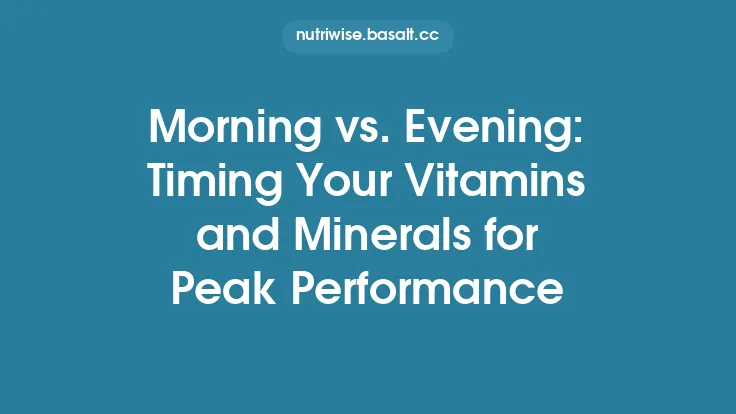Probiotic supplements have become a staple for many seeking to support their digestive health, but simply taking a capsule or powder does not guarantee that the beneficial microbes will successfully reach and colonize the gut. The timing of ingestion plays a pivotal role in determining how many live organisms survive the harsh journey through the upper gastrointestinal (GI) tract, adhere to the intestinal lining, and ultimately become part of a stable microbial community. Below is a comprehensive guide that walks you through the physiological factors influencing probiotic colonization and offers evidence‑based timing strategies to maximize the odds that your supplement will do what it’s intended to do.
Understanding Colonization Dynamics
Colonization is a multi‑step process that begins the moment a probiotic leaves the container and ends when the microorganisms establish a foothold within the intestinal ecosystem. The key stages are:
- Survival through the Stomach – The acidic pH (1.5–3.5) and digestive enzymes can inactivate a large proportion of ingested microbes.
- Transit through the Small Intestine – Bile salts and pancreatic enzymes present additional hurdles, especially for strains that are not inherently bile‑tolerant.
- Adhesion to the Mucosal Surface – Successful colonizers express surface proteins (e.g., mucus‑binding proteins, pili) that enable them to attach to the epithelial glycocalyx.
- Integration into the Resident Microbiota – Once attached, the probiotic must compete for nutrients and niche space, often forming biofilm‑like structures that protect them from peristalsis and immune clearance.
Each of these steps is influenced by the physiological state of the host at the moment of ingestion. By aligning supplement intake with periods when the GI environment is most permissive, you can dramatically improve the proportion of viable cells that make it to the colon.
The Role of Gastric Environment in Probiotic Survival
Acidic Buffering by Food
When the stomach is empty, the pH can drop below 2, a level that is lethal for many probiotic species. Consuming a probiotic with a small amount of food—particularly foods that contain proteins or fats—temporarily raises gastric pH to 4–5, providing a protective buffer. This effect typically lasts 30–90 minutes, depending on the meal composition and gastric emptying rate.
Timing Relative to Gastric Emptying
The rate at which the stomach empties its contents into the duodenum follows a predictable pattern:
- Liquids: 15–30 minutes
- Semi‑solid meals: 30–60 minutes
- High‑fat meals: 60–120 minutes
If a probiotic is taken immediately before a high‑fat meal, the delayed gastric emptying can expose the microbes to prolonged acidic conditions, reducing survival. Conversely, taking the supplement 30–45 minutes after a moderate meal aligns the probiotic’s entry into the duodenum with the peak of gastric pH buffering.
Bile Salt Interaction
Bile secretion is stimulated by the presence of fats and, to a lesser extent, proteins. While bile salts are essential for lipid digestion, they can disrupt bacterial cell membranes. Some probiotic strains possess bile‑salt hydrolase (BSH) activity, which confers resistance. Timing a probiotic during a low‑fat window (e.g., mid‑morning or mid‑afternoon) can reduce bile exposure, especially for non‑BSH strains.
Meal Timing and Nutrient Interactions
Pre‑Meal vs. Post‑Meal Ingestion
| Timing | Gastric pH | Bile Secretion | Typical Survival Rate* |
|---|---|---|---|
| 30 min before a meal | Very low (≈1.5–2) | Minimal | 5–15 % |
| During a light snack | Moderate (≈3–4) | Low to moderate | 30–45 % |
| 30 min after a balanced meal | Elevated (≈4–5) | Moderate | 50–70 % |
| Immediately before bedtime (fasted state) | Low (≈2) | Low | 10–20 % |
\*Survival rates are approximate and derived from in‑vitro simulations and human crossover studies.
Optimal Nutrient Pairings
- Proteins (e.g., yogurt, cheese, lean meat) provide amino acids that can act as nitrogen sources for probiotic metabolism and help raise gastric pH.
- Complex carbohydrates (e.g., whole‑grain toast, oatmeal) slow gastric emptying, extending the buffering window.
- Healthy fats (e.g., avocado, nuts) should be limited to <10 g per serving when timing a probiotic, as they trigger a robust bile response.
A practical rule of thumb is to pair the probiotic with a small, protein‑rich snack (≈10–15 g protein, <5 g fat, 15–20 g carbohydrate) and consume it 30–45 minutes after a main meal. This combination offers the best compromise between pH buffering and manageable bile exposure.
Circadian Rhythms and Microbial Activity
The human gut exhibits diurnal fluctuations in motility, pH, and immune activity, all of which are orchestrated by the central circadian clock. Recent chronobiology research indicates that:
- Morning hours (6 am–10 am): Gastric acidity is at its peak, and intestinal motility is relatively low.
- Mid‑day (11 am–2 pm): Gastric pH rises modestly after breakfast, and bile secretion is moderate.
- Late afternoon/evening (4 pm–8 pm): Small‑intestine transit slows, providing a longer window for probiotic adhesion.
Aligning probiotic intake with the mid‑day to early evening window leverages the natural dip in gastric acidity and the slower intestinal transit, both of which favor higher survival and adhesion rates. For shift workers or individuals with irregular sleep patterns, the key is to maintain a consistent interval between meals and probiotic ingestion, rather than adhering strictly to clock time.
Interactions with Medications and Supplements
Antibiotics
Concurrent antibiotic therapy dramatically reduces probiotic viability. The optimal strategy is to space probiotic intake at least 2–3 hours after an antibiotic dose, allowing the antibiotic concentration in the lumen to fall below inhibitory levels. In prolonged courses, a post‑antibiotic “re‑colonization phase”—starting 48 hours after the final dose—maximizes restoration of microbial diversity.
Proton Pump Inhibitors (PPIs) and H2 Blockers
These drugs raise gastric pH, which can paradoxically improve probiotic survival. However, chronic suppression of acid can alter the composition of the native microbiota, potentially diminishing the niche for introduced strains. For patients on long‑term PPIs, a single daily probiotic dose taken with a light snack is sufficient; additional doses provide diminishing returns.
Iron Supplements
Oral iron can create a pro‑oxidative environment in the gut, impairing probiotic cell membranes. If iron supplementation is necessary, schedule the probiotic at least 1 hour before or 2 hours after the iron dose.
Other Nutraceuticals
Compounds such as polyphenols (e.g., green tea catechins) possess antimicrobial properties that may affect probiotic viability. When consuming such agents, maintain a minimum 30‑minute gap between the probiotic and the polyphenol‑rich beverage.
Practical Timing Protocols for Different Lifestyles
| Lifestyle | Recommended Timing | Rationale |
|---|---|---|
| Sedentary office worker | Take probiotic with a mid‑morning snack (≈10 am) 30 min after breakfast | Utilizes post‑breakfast pH buffering; avoids high‑fat lunch that spikes bile. |
| Active athlete | Ingest probiotic 30 min after a post‑workout recovery meal (protein‑carb blend) | Exercise transiently increases gut permeability; post‑exercise feeding provides a protective buffer and nutrients for colonization. |
| Frequent traveler | Carry single‑dose sachets; take immediately after a light, protein‑rich snack upon arrival, preferably within 2 hours of a meal | Mitigates stress‑induced gastric acid spikes and aligns with irregular eating schedules. |
| Night‑shift worker | Align probiotic intake with the first main meal after waking, regardless of clock time, and 30 min after that meal | Maintains consistency with the body’s circadian‑linked digestive phases. |
| Elderly individual | Take probiotic with a small, low‑fat breakfast (e.g., yogurt with fruit) 30 min after the meal | Compensates for age‑related reductions in gastric acid secretion and slower gastric emptying. |
Special Considerations: Age, Health Status, and Travel
- Infants and Young Children: Their gastric pH is naturally higher (≈4–5), which reduces the need for buffering. However, the immature immune system can be more reactive. A single daily dose taken with a breast‑milk or formula feeding is generally sufficient.
- Immunocompromised Patients: Even modest probiotic doses can pose a risk of translocation. Timing should be coordinated with the treating physician, and administration should be paired with a sterile, low‑pH‑buffering medium (e.g., a small amount of sterile water) to limit over‑growth.
- Travelers to High‑Altitude or Extreme Climates: Altitude can alter gastric emptying and increase gastric acidity. In such settings, consume the probiotic with a high‑protein snack and consider a micro‑encapsulated formulation that offers additional acid protection.
- Pregnant and Lactating Women: Hormonal shifts can affect motility and pH. The safest approach is to take the probiotic with a balanced meal (e.g., whole‑grain toast with avocado) 30 minutes after eating to ensure maximal survival without excessive bile exposure.
Monitoring Colonization Success
While direct measurement of colonization typically requires stool sequencing—a service beyond most consumers—there are practical proxies to gauge effectiveness:
- Symptom Tracking: Improvements in bloating, regularity, and occasional abdominal discomfort within 2–4 weeks often correlate with successful colonization.
- Digestive Tolerance Tests: Simple at‑home breath tests (e.g., hydrogen breath after a lactulose challenge) can indicate shifts in microbial fermentation patterns.
- Biomarker Kits: Emerging over‑the‑counter kits measure short‑chain fatty acids (SCFAs) in stool, offering indirect evidence of functional microbial activity.
If desired outcomes are not observed after a minimum 4‑week trial, consider adjusting timing (e.g., shifting from pre‑meal to post‑meal) or consulting a healthcare professional for strain‑specific recommendations.
Common Pitfalls and How to Avoid Them
| Pitfall | Why It Happens | Corrective Action |
|---|---|---|
| Taking probiotics on an empty stomach | Low gastric pH kills most cells | Pair with a small snack or wait 30 min after a meal |
| Consuming high‑fat meals immediately before or after | Bile salts disrupt cell membranes | Limit fat to <5 g per probiotic dose; schedule 30–45 min after a balanced meal |
| Concurrent antibiotic dosing without spacing | Antibiotics eradicate the probiotic | Separate doses by ≥2 hours; consider a post‑antibiotic re‑colonization phase |
| Skipping doses due to “forgetting” | Inconsistent exposure reduces niche establishment | Use a daily reminder app or integrate the probiotic into an existing habit (e.g., after brushing teeth) |
| Assuming more is better | Excessive CFU does not overcome poor timing; may increase GI upset | Follow label dosage; prioritize optimal timing over sheer quantity |
Summary of Best Practices
- Buffer the Stomach: Take the probiotic with a modest, protein‑rich snack or 30–45 minutes after a balanced meal to raise gastric pH.
- Mind the Bile: Avoid high‑fat meals within the hour surrounding probiotic ingestion, especially for non‑BSH strains.
- Leverage Circadian Windows: Mid‑day to early evening offers the most favorable GI conditions for survival and adhesion.
- Separate from Interfering Medications: Space probiotic intake at least 2–3 hours from antibiotics, iron, and strong antimicrobials.
- Tailor to Lifestyle: Align timing with personal schedules—whether that’s a post‑workout snack, a night‑shift meal, or a travel-friendly sachet.
- Track Outcomes: Use symptom logs or simple at‑home tests to confirm that the timing adjustments are translating into functional benefits.
By respecting the physiological landscape of the digestive tract and synchronizing supplement intake with optimal windows, you give your probiotic the greatest possible chance to survive, adhere, and become a lasting contributor to a healthy gut microbiome.





